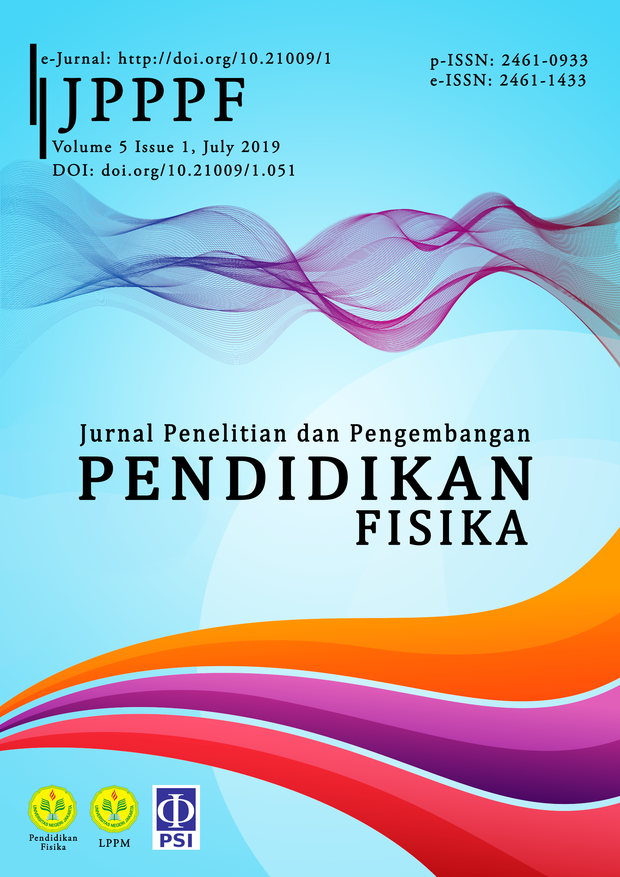Guided Inquiry Scratch Increase Students' Critical Thinking Skills on the Linear Motion Concept: Can it be?
DOI:
https://doi.org/10.21009/1.05107Keywords:
guided inquiry scratch, critical thinking skills, linear motion conceptAbstract
The 4C-oriented 21st century competency education consists of critical thinking and problem solving, creativity, communication skills and Ability to Work Collaboratively. Guided inquiry learning strategy combined with scratch technology is needed to train students' critical thinking skills. The study aims to determine the improvement of students' critical thinking skills after being given Guided Inquiry assisted by Scratch media on the Linear Motion concept. The quasi-experimental study with the design of one group pre-post test design was conducted in class VIII B of SMP Negeri 1 Banjarharjo in the academic year 2018/2019. The pre-test results showed that 16.67% of students were categorized quite critical to very critical and 83.33% of students in the less critical category were not even critical. The post test results showed that 91.66% of students were categorized quite critical to very critical and 8.34% of students in the less critical category were not even critical. The results of data analysis also showed an increase in students' critical thinking skills by 0.56 with moderate criteria. The application of guided inquiry learning assisted by scratch media can train and increase students' critical thinking skills on the concept of linear motion.
References
Arends, R I, 2012, Learning to Teach Ninth Edistion, New York: The Mc Graw-Hill Companies, inc.
Corlu, M A & Corlu, M S, 2012, ‘Scientific Inquiry Based Professional Development Models in Teacher Education’, Education Science: Theory and Practice, vol. 12(1), pp. 514-521.
Martanti, A. P. W, Hardyanto. & A. Sopyan, 2013, ‘Pengembangan Media Animasi Dua Dimensi Berbasis Java Scratch Materi Teori Kinetic Gas untuk Meningkatkan Pemahaman Konsep Peserta didik SMA’, UNNES Physics Education Journal, vol. 2(2), pp. 19-25.
Minner, D D, Levy, A J & Century, J 2010, ‘Inquiry-based science instruction-what is it and does it matter? Results from a research synthesis years 1984 to 2002’, Journal of Research in Science Teaching, vol. 47, pp. 474-496.
P21, 2015, Framework for 21st Century Learning, http://www.p21.org/our-work/p21-framework (download on 26 November 2018).
Sarwi, Sutardi & Prayitno, W W, 2016, ‘Implementation of guided inquiry physics instruction to increase an understanding concept and to develop the students' character conservation’, Jurnal Pendidikan Fisika Indonesia, vol. 12(1), pp. 1-7.
Subhan, Salempa, P & Danial, M 2018, ‘Pengaruh media animasi dalam model pembelajaran inkuiri terbimbing terhadap keterampilan berpikir kritis dan aktivitas belajar peserta didik pada materi kesetimbangan kimia’, Chemistry Education Review (CER) Pendidikan Kimia PPs UNM, vol. 1(2), pp. 125-141.
Sutrisno 2012, Kreatif mengembangkan aktivitas pembelajaran berbasis TIK. Jakarta: Referensi.
Syahdiani, Kardi, S & Sanjaya, I G M, 2015, ‘Pengembangan multimedia interaktif berbasis inkuiri pada materi sistem reproduksi manusia untuk meningkatkan hasil belajar dan melatihkan keterampilan berpikir kritis peserta didik’, Jurnal Pendidikan Sains Pascasarjana Universitas Negeri Surabaya, vol. 5(1), pp. 727-741.
Vlassi, M & Karaliota, A 2013, ‘The comparison between guided inquiry and traditional teaching method. A case study for the teaching of the structure of matter to 8th grade Greek students’, Procedia - Social and Behavioral Sciences, vol. 93, pp. 494-49.
Wang, H & Posey, L 2011, ‘An inquiry-based linear algebra class, online submission’, US-China Education Review, vol. B 4, pp. 489-494.
Wiyanto 2008, Menyiapkan Guru Sains Mengembangkan Kompetensi Laboratorium, Semarang: Universitas Negeri Semarang Press.
Zubaidah, Siti 2016, ‘Keterampilan abad ke-21: keterampilan yang diajarkan melalui pembelajaran’, Makalah, Seminar Nasional Pendidikan STKIP Persada Khatulistiwa Sintang Kalimantan Barat, December 10, 2016.











